#ESPECIALLY in the medieval era
Text
#polls#pear of anguish#torture#yeah this is it this is probably the most insane poll i’ve ever run#but like#come on#the craftsmanship that would be required#ESPECIALLY in the medieval era#that’s not being wasted on torture devices#especially when you can cause the same amount of pain with a pair of pliers
5 notes
·
View notes
Text
Someone needs to do an analysis on the way the Kung Fu Panda movies use old-fashioned vs. modern language ("Panda we meet at last"/"Hey how's it going") and old-fashioned vs. modern settings (forbidden-city-esque palaces/modern-ish Chinese restaurant) to indicate class differences in their characters, and how those class differences create underlying tensions and misunderstandings.
#This is neither a criticism nor a compliment of that artistic choice#I just think it's really interesting#Like even looking at the Five:#Tigress talks in an older style than the others because she was mainly raised at the Jade Palace#While Mantis talks like Joe-schmo off the street because he *was* a streetfighter and an ordinary guy#Shifu and even Tai Lung talk like they're from an old-fashioned novel or kung fu movie#Po talks like a modern guy you'd meet working in a twenty-first century family restaurant#Part of Tigress's initial disdain for him in the first movie is clearly because she considers him to be low-class/a commoner#(And therefore an intruder into the world of the Jade Palace and the rest of the Kung Fu masters which appears to be semi-noble).#Shen looks genuinely off-put and disgusted when he has to respond to Po's greeting with a “...hey.”#And when Po wants to appear more legitimate as a warrior he adopts a more “legendary”/old-fashioned way of speaking.#In the aesthetic language of KFP old fashioned=noble/upper class and modern=common/lower class.#This translates entirely naturally—I think especially to an American audience—but it is wild once you notice it#Because you realize: “Hang on—shouldn't *all* these characters be talking like they're living in the medieval era?”#“And what does it mean that they're not? What is the movie attempting to convey with this—probably entirely subconscious—artistic choice?”#kung fu panda
880 notes
·
View notes
Note
About the accents: if someone has a very "proper" Italian they are either foreigners or politicians/dignitaries/etc. So that fits perfectly for Machete, but I think it would be so funny if he sometimes slipped up and used a Nepalese word bc he forgot one in "proper" Italian lol
(Funny to me cause Naples has its own language in addition to accent, and most people don't actually know those words)
.
#ah that's good to hear!#glad it fits him#there's no way he gets it perfect every time#especially in the absence of widely used standardized Italian in the original canon era#there's bound to be a mix up every now and then#I don't know how likely it would be that he absorbed much Venetian at the time he lived there#I remember reading that lectures in medieval and early premodern universities were held in Latin but I could be wrong#even though his original native language is Sicilian I think he has probably lost a lot if not most of it due to lack of use#but it would be kind of funny if the Neapolitan and/or Sicilian influences resurfaced occasionally in private casual conversations#and Vasco who to my knowledge has never been to the south would be left guessing what he was even trying to say#I'm taking the easy way out and lowering their language barriers a bit out of convenience bear with me#I'm not competent enough to deal with all the different languages and dialects and the communication issues that would come with them#answered#anonymous#sorry to point out an obvious typo but I think you must've gotten Neapolitan/Napolese autocorrected to Nepalese by accident or something#unless Machete has secret ties to Nepali that I'm not aware of#which would be quite a twist
177 notes
·
View notes
Text
A take on Exodus and Eobar's first meeting.
----------------------------------
Words: 879
Rating: General
#obsessed with how much of exodus' approach to Christianity is just heresy really#especially for the era#also medieval lent was a lot#sorry for the thees and thous but i wanted to keep the class dynamic obvious in speech like it would've been at the time#exobar#Katatonic_State
18 notes
·
View notes
Text
and it goes without saying that the state of art history/visual culture video essay youtube is a bit dire. in that it like, doesnt exist outside of a few one off videos by general youtubers, decade old recordings of lectures, and random short text to speech videos that are likely ai generated
#we know the wonderful jacob geller whos afraid of red yellow and blue essay#and drapetomania is really fantastic especiall on the visual culture side of things especially with race#(which is one of my biggest personal areas of interest so i might be biased LOL but someone has to be biased about this)#(unrelated but sometimes im in my art history classes which. while in recent years have become slightly more diverse)#(still lean quite white and like. they do their best. theyre willing to listen. but theres a lot of blindspots)#(so the least i can do is be really loud and mixed race in class HDJKFKDF)#but its rough if someone wants some to know more of the beginner stuff. like more accessible for some of the basics#like not just the basics of the theory aspects (although that is important) but also like the basics of the history aspects#hell i have a lot of blindspots with certain eras and movements. dont ask me about medieval art i dont know like anything 😔#i dunno i think theres a gap in educational focused youtube that could be filled? it could be fun#not by me though i cant read a script for shit LOL if u want the bmpmp3 art history video essay then find me irl in a museum and ask me a#question and i will give you my entire bachelors degree in the next hour or two. like nature intended for us art history majors
1 note
·
View note
Text
i think ive ur gonna post videos about ‘medieval era’ versions of kpop songs you should try making some joseon era versions. i would just like to see it .
#jordan talks#i want to see someone try n simulate the song in that style tbh#not that the ‘medieval’ ones are ever very much like western medieval music but#i want u to see videos that are like ‘when the left state minister accuses you of treason’ instead of like idk whatever these vids are sayin#like i love the western medieval era too but . pls#i just think it would be interestinf especially since kpop is so heavily influenced by western music???#idk
0 notes
Text
Many people, especially USAmericans, are very resistant to knowing the plants and living according to the ways of the plants. They lash out with a mix of arrogance and fear: "Don't you know what bad things would happen if we lived a different way? There is a REASON for living this way. Would you have us go Back—backward to the time without vaccines or antibiotics????"
Ah, yes, the two immutable categories that all proposals for change fit into: Backward Change and Forward Change! Either we must invent a a futuristic, entirely new solution with SCIENCE and TECHNOLOGY that further industrializes and increases the productivity of our world, or we must give up vaccines and antibiotics and become starving illiterate medieval peasants.
Every human practice anywhere on Earth that has declined, stopped, or become displaced by another practice, was clearly objectively worse than whatever replaced it. You see, the only possible reason a way of life could decline or disappear is that it sucked and had it coming anyway!!! Pre-industrial human history is worthless except as a cautionary tale about how miserable we would all be without *checks notes* factories, fossil fuels and colonialism. Obviously!
Anyway, who do you think benefits from the idea that pesticide-dependent, corporate-controlled industrialized monoculture farming liberates us all from spending our short, painful lives as filthy, miserable peasants toiling in the fields?
First of all, I think it's silly to act like farming is a uniquely awful way to live. I can't believe I have to say this, but the awful part of being a medieval peasant was the oppression and poverty, not the fact that harvesting wheat is a lot of work and cows are stinky. Same goes for farm labor in the modern USA: the bad part is that most people working farms are undocumented migrant workers that are getting treated like garbage and who can't complain about it because their boss will rat them out to ICE.
Work is just work. Any work has dignity when the people doing it are paid properly and not being abused. Abuse and human trafficking is rampant in agriculture, but industrialization and consolidation of small farms into gigantic corporate owned farms sure as hell isn't making it better.
Is working on a farm somehow more miserable than working in a factory, a fast food restaurant, or a retail store? Give me a break. "At least I'm not doing physical labor in the sun," you say, at your job where you're forced to stand on concrete for 8 hours and develop chronic pain by age 24.
When you read about small farmers going out of business because of huge corporations, none of them are going "Yay! Now that Giant Corporation has swallowed up all the farms in the area, we can all enjoy the luxurious privileges of the industrial era, like working RETAIL!" What you do see a lot of is farmers bitterly grieving the loss of their way of life.
And also, the fact is, sustainable forms of polyculture farming that create a functional ecosystem made up of many different useful and edible plants are actually way MORE efficient at producing food than a monoculture. The reason we don't do it as much, is that it can't be industrialized where everything is harvested with machines.
Some places folks are starting to get the idea and planting two crops together in alternating rows, letting the mutualistic relationship between plants boost the yields of both, but indigenous people in many parts of the world have been doing this stuff basically forever. I read about a style of agroforestry from Central America that has TWENTY crops all together on the same field.
Our modern system of farming is necessary for feeding the world? Bullshit! Our technology is very powerful and useful, but our harmful monocultures, dangerous pesticides, and wasteful usage of land and resources are making the system very inefficient and severely degrading nature's ability to provide for us.
What is needed, is a SYNTHESIS of the power and insights of technology and science, with the ancient wisdom and knowledge gained by closely and carefully observing Nature. We do not need to reject one, to embrace the other! They should be friends!
Our system thinks land is only used for one thing at a time. Even our science often thinks this way. A corn field has the purpose of producing corn, and no other purpose, so all other plants in the corn must be killed, and it must be a monoculture of only corn.
But this means that the symbiosis between different plants that help each other is destroyed, so we must pollute the earth with fertilizers that wash into bodies of water and cause eutrophication, where algae explode in number and turn the water to green goo. Nature always has variety and diversity with many plants sharing the same space. It supports much more animal life (we are animals!) this way. The Three Sisters" are the perfect example of mutualism between plants being used in an agricultural environment. The planting of corn, beans, and squash together has been traditionally used clear across the North American continent.
And in North America, the weeds we have here are mostly edible plants too. Some of them were even domesticated themselves! Imagine a garden where every weed that pops up is also an edible or otherwise useful crop, and therefore a welcomed friend! So when weeds like Amaranth and Sunflower pop up in your field, that should not be a cause for alarm, but rather the system of symbiosis working as it should.
A field of one single crop is limited in how much it can produce, because one crop fits into a single niche in what should be a whole ecosystem, and worse, it requires artificial inputs to make up for what the rest of the plant community would normally provide. The field with twenty crops does not produce the same amount as the monoculture field divided in twenty ways, but instead produces much more while being a habitat for wild animals, because each plant has its own niche.
2K notes
·
View notes
Text
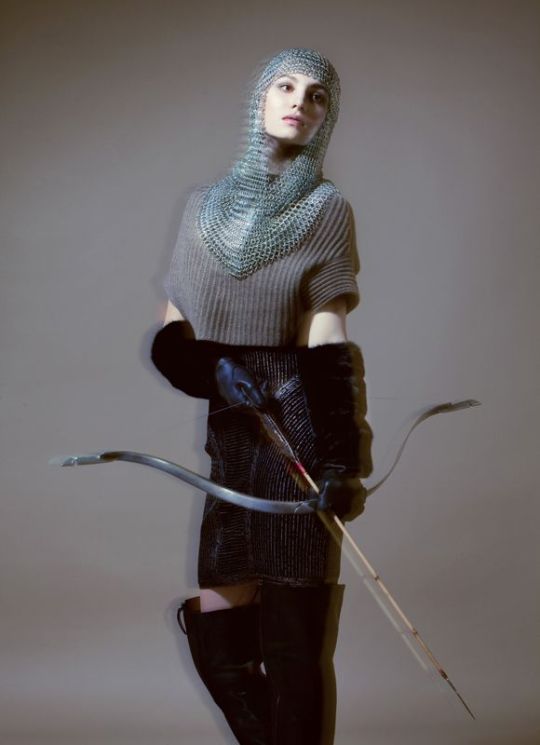
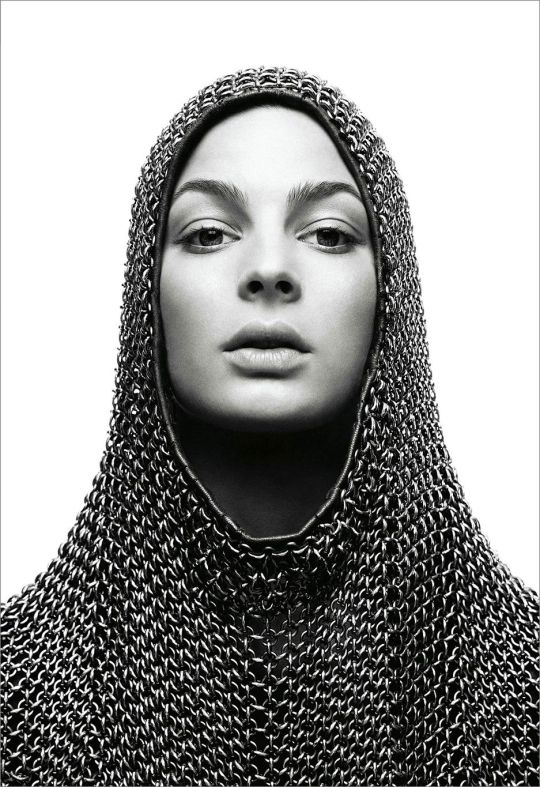
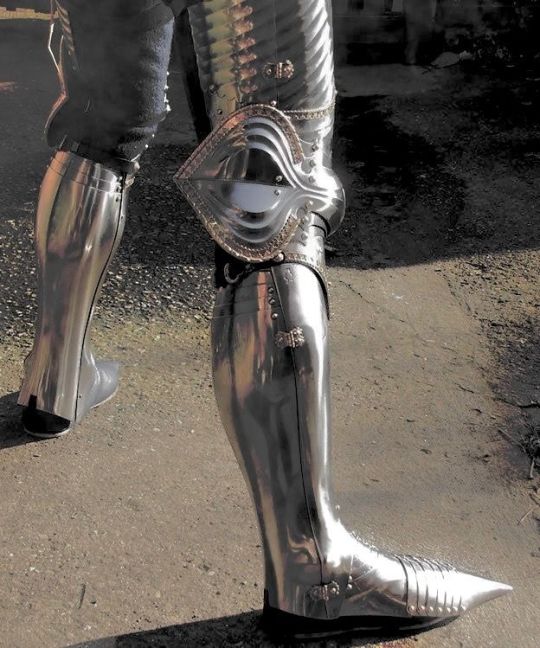

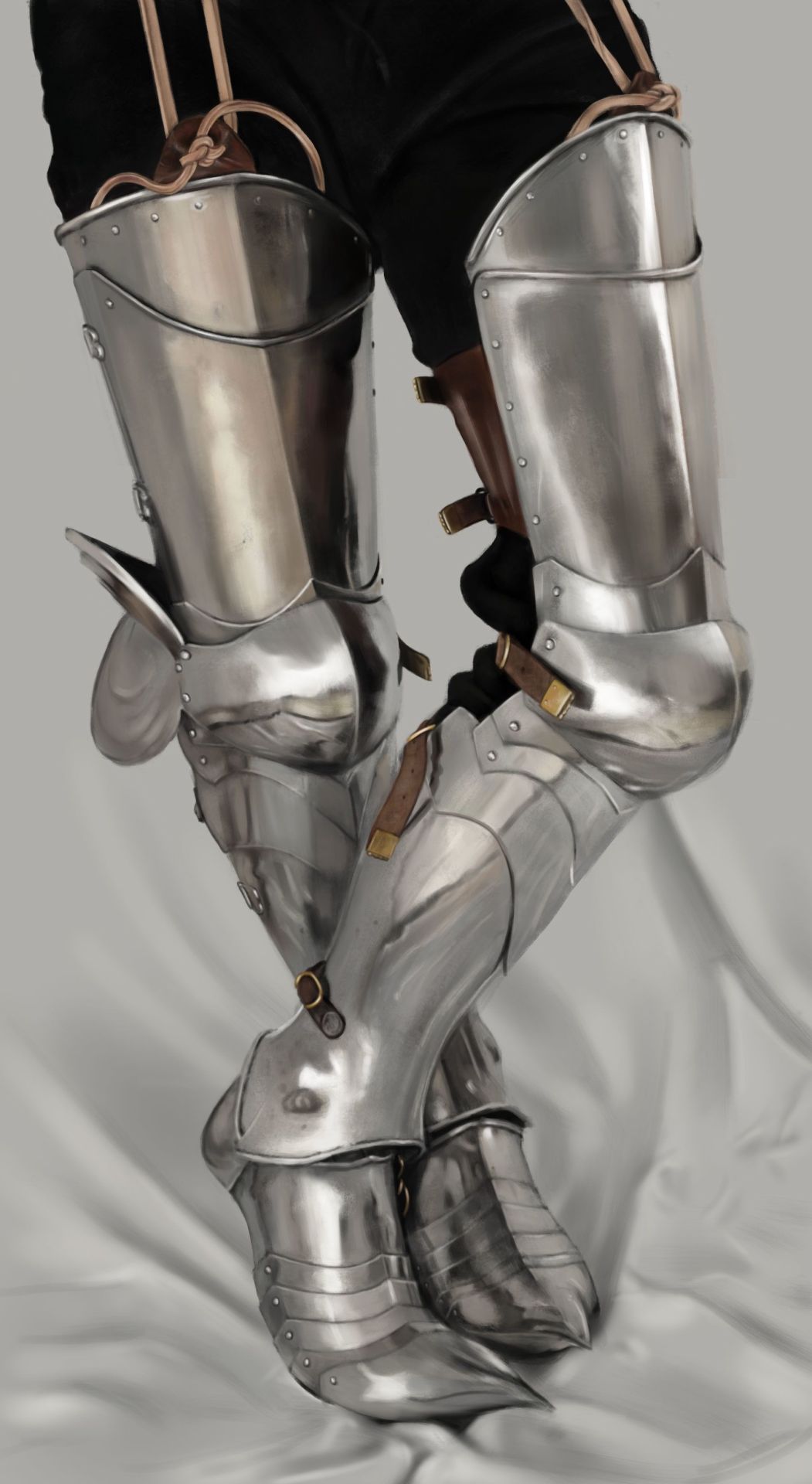

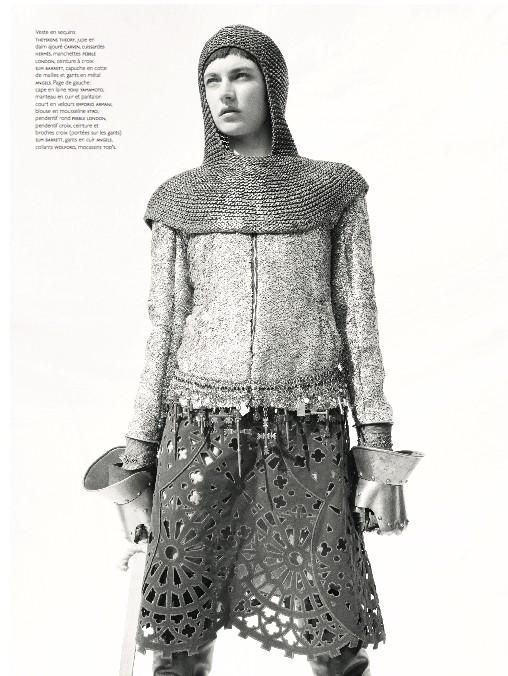
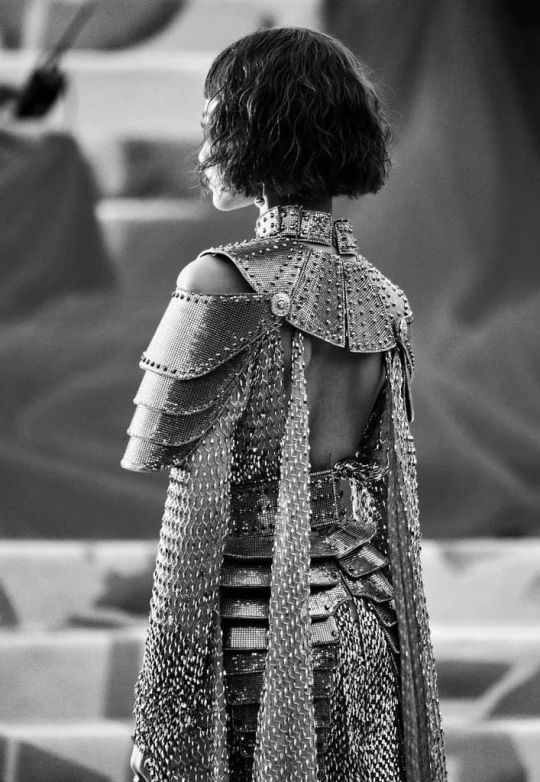
inspired by another post, but one of my favorite things in [high] fashion is the usage of knight aesthetics, armor, weaponry, chainmail, and medieval imagery, especially in women. here are some of my favorite images using these inspirations!
i luv the recycling of historical eras and interweaving pasts and presents and futures into a single look, without losing any of them <3
#knightcore#joan of arc#medievalcore#royalcore#high fashion#fantasycore#some of these arent high fashion#fourth picture is a drag king
4K notes
·
View notes
Text
♡ 𝐂𝐡𝐚𝐩𝐭𝐞𝐫 𝐓𝐰𝐨 | 𝐒𝐰𝐞𝐞𝐭𝐞𝐫 𝐓𝐡𝐞𝐧 𝐁𝐞𝐢𝐧𝐠 𝐃𝐫𝐮𝐧𝐤 ♡
【Synopsis】 : The aftermath of Seonghwa ravishing, you had left your thirsty. Good thing whole you wander through the large easte, a grumpy vampire is more than happy to help show you the kitchen. After all, he, too, is thirsty.
『Word count』 : 1.89k
-> Genre: Fantasy. Gore. Suggestive. Mafia au.
Pairing: Vampire!Yeosang x Reader | Vampire!Seonghwa x Reader [Eventual Poly]
[Warnings] : Mention of sex. Blood drinking. Kissing. Seonghwa is already whipped for the reader. Nakedness. Pet names. Swearing. Mention of death. Mention of gore scenes involving flesh being ripped from bone by teeth. (whoops) Blood drinking. Yeosang is a grumpy boy. Modern meets medieval
Part One | Masterlist | Mini Series Materlist | Navigation


564 years later
Music infected the brain making it hard to hear your own thoughts. Liquor was everywhere. From the mouths of the drunk to the floor of the poor bar. Night clubs were where singles could find a chance to walk home with another and takens to hide their love affairs. It was sickening, to say the least. People throwing themselves at each other, hands falling to parts of the body only the private eye should take advantage of. Guess the saying "think with your dick" was invented at a club because all everyone does here is just that.
Yeosang sat quietly in the VIP lounge, sipping his drink while closely watching his entertainment for the evening. A piss poor excuse for humanity. He regrets agreeing to this ordeal now. Why couldn't San be the watchman or even Wooyoung? They love to spend time around humans. Especially when they get to drink off them. Yeosang was not the same. The idea of partying or drinking from a filthy human's neck, it scream disease in this era...
The thought makes Yeosang cringe. Have you ever tasted the flavour of a sexual disease in blood? It’s not pleasant. Bitter, tangy, and downright vial. Like tasting death. But alas no matter how much Yeosang pleaded his pain to the older males, they declined saying ‘We need you there tonight. Everyone else has their duties, now do yours’. Yeosang huffs reminding himself he needs to kill San and Wooyoung the next time he sees them.
His eyes wandered aimlessly at the passing face. One of his jobs here was not just to see who entered the club but to also do some side deals, moving drugs, importing expensive alcohol. You name it. So of course that means he had to deal with humans. Typical drunk humans. Typical horny drunk humans. Typical…. “Wait….” Yeosang cut off the cowardly man in front of him with the raise of his finger. His eyes locked on to a young woman dressed in black sitting at his bar. She was nursing a drink while another woman in a tight skimpy dress had caught her attention. They seemed to be chatting about something. More like yelling at one another but that was beside the point. The girl in black looked so familiar like he had met her before, a long time ago.
—
You shifted slightly, feeling an ache on your upper thighs. Your eyes were hazy, trying to look around the dim room. You felt a weight on your waist, making it hard to move. Your head turned to the side seeing Seonghwa’s peaceful face. You could still see some of your blood stained on his bottom lip. A tingle surged against your neck, reminding you about the small wound on it. Hwa hadn’t full-on bit you like vampires would normally do to their prey but the idea still lingered on your mind. He was a beast that had fed from you, slept with you and you like it? Something must be wrong with you.
“I can feel you staring at me.” His voice was deeper, more gravelled. It sent shivers down your spine. But you didn’t know how to answer, so instead, you leaned in closer, sealing your lips on his. He gladly took them, deepening the sensual yet passionate kiss. It didn’t last as long as Seonghwa would have liked though, as you pulled away you spoke softly.
“I’m going to go get a drink.” You shifted once again but this time, pulling away from Hwa’s bare body. He whined in the loss of your warmth but you just giggled reassuring him you wouldn’t be long.
“Are you sure you don’t need me to go with you? It’s still sunny out. No one will be awake other than our workers.” He yawned clearly still in rest mode. Once again you eased his mind by saying if you needed help you’re sure one of the workers would help. And as you finished chatting to a sleepy Seonghwa while putting on your sleepwear, you left, slowly making your way down the hall. It might been dim inside but the sun was slinking its way in through some of the curtains as you passed them. One by one, until you reached the end of the seemingly never-ending hallway. It dawned on you that maybe you should have taken Seonghwa’s advice about him going with you or maybe just asked him which direction was the kitchen.
Huffing out, you place your hands on either side of your hips, trying to think about where it could possibly be but your thoughts don’t last long as a tall man with thick biceps and slicked back hair that seemed to have a slight tinge of green in it appeared suddenly. He was very handsome, just like the others and the minute he closed the door behind him he knew you were in the all with him. A low grumble surged through him, making the vibrations disturb the ground, shocking its way up your legs. H was intimidating but you weren’t scared. If anything you felt safer with the idea of creatures like him roaming around, making you aware no human from your village and by that you mean your mother, would have no second thought in coming to the ruined castle.
“Wooyoung was right, you do have a staring problem.” His sharp voice made your heart sting a little. He seemed uninterested in you compared to the others. Which you didn’t mind but part of you wanted to know why? What made him feel different?
“I uh…” He had caught you so suddenly, that you probably looked like a deer in headlights from his perspective which made a sly smile paint his god-like features.
“Cat got your tongue, human?” He made it painfully aware to you that he was no mortal like you, showing off his fangs in the smile. His eyes were glowing and he was clearly not in the mood for small talk. Taking a few steps, he was suddenly in front of you. You could finally take in some details noting he was still wearing outing clothes instead of sleepwear. It only then dawned on you, that he was either Hongjoong or Yeosang. The vampires you hadn’t met yet. his smirk faded quickly, huffing out a shallow breath. He took one last step in front of you, chest to chest to him. Letting you feel his breath on your cheek, your heart started racing. You could smell death around him as if he had been hunting recently. His eyes staring at you harshly, such a familiar gaze. And then you realized as you noticed some of the blood stains sticking out from his undershirt who he was…
“Y-You are the one I saw last night. The one that bit…” Your voice was slacked and shaky, with your eyes wide. His pupils were blown out, with his iris’s changing from a brown to a deep red. His fingers dance along your exposed collarbone, dragging up over the already healed where Seonghwa had pricked you a couple of hours ago.
“Oh no, Pet…” His chuckle was dark, seductive. “I ripped his jugular out.” His words made your breath hitch, imagining long teeth shredding flesh down to the bone against Lucas’s neck. His face tilted down towards your neck, rubbing his nose against your skin. “He tasted fowl, tainted. I’m surprised if he lasts the day.” his tongue licked a stripe up your hot neck, taking in your scent.
“He’s still alive?” Again with the stupid questions. Did you even care about knowing? Why would you want to know about the life of a guy who could have done such terrible things to you?
“For now…” He pulled away with a groan, his hands holding your waist. “Sadly Hongjoong had patched him enough so if he is…'strong', then I guess he’ll live.” It fell silent for a moment, you had no idea how to respond. So he was Yeosang and from what you’ve heard, he was known for having a temper. “Enough about him. I’m more interested in why Hwa didn’t bite you properly. Hmm? All that talk about being your first for everything and oh I mean everything. Yet he didn’t drink from you?”
Your face was flustered at his words. Seonghwa wanted to be your first in everything. How long have these men been watching you? You gulped, not breaking eye contact with the vampire. His lip was sucking in tightly between his teeth, taking in yet another deep breath, as if he needed to get your scent in his system to live. “I guess he wouldn’t mind if I took the offer.”
Your eyes widened, feeling his grip tighten on your hips. One hand freed itself, snaking out to the back of your neck, pulling your head to the side sharply. You hissed at his forcefulness but did not dare to voice any such uncomfortableness, not wanting him to push away from your aching body. He didn’t waste another breath, not caring whether you even wanted this or not, licking a strip along your main vein before his long sharp fangs sank into your soft flesh.
“Y-Yeo…” You squirmed against him, the pain was nothing like you experienced before. It wasn’t a burning pain like a broken bone or a sprained ligament but a dizzy pain. One that is mixed with pleasure, or euphoric notions. You felt like your brain was in the clouds, untouched, protected. His grip got tighter, the hand that held your hip was now wrapped around your middle, caging you in his tight grasp. Your fingers dig into his shoulders, pulling at his tunic. His groans rumbled in your ears, making your core wet.
He finally pulled back, blood pouring down his chin, staining his button-up and neck. His groans were music to your ears, the velvet vocals melting your brain. “Fuck pet, if I’d kept going I’d drink you dry. I’ve never tasted such sweetness.” He lapped at your wounds, cleaning any blood that had spilled out down your collarbone. The air seemed thinner to you, while your heart was racing, trying to pump more blood in you from the large amount you had just lost. “I wonder if other parts of you hold such palatableness.”
You had no clue the meaning behind his rambles, but if they meant anything like Seonghwa’s charming words, you soon realized where it makes you end up. He finally lets go of your head, your neck completely clean to the best of his abilities. Sadly he couldn’t say the same about your pj’s. one a nice baby blue, now covered in crimson. Your head was dizzy but no longer just from the loss of blood but more so from the intoxicating undead beast holding your caringly. Your body was yearning for him, like some sickness, wanting nothing other than these vampiric men. Not one, not two, but all of them.
—
Yeosang couldn’t control his feet, weaving quickly through the crowd, trying to get to the hypnotic woman sitting at the bar, but as he finally pushed the last drunk pig of a human past him, the woman was gone. He stood there for a moment, in disbelief. Was he dreaming? Was he losing his mind? Becoming unattached from the world? Raking his fingers through his hair he sighed out a frustrating growl, needing to contact someone. Holding his finger in his ear and the phone to the other, he searched through his contacts, but no one seemed to answer not until one did, “Jongho I think I just saw her…”
-♡
#ateez#ateez smut#ja3hwa#ateez scenarios#ateez imagines#ateez reaction#ateez reactions#ateez fanfic#ateez fluff#ateez scenario#ateez x reader#ateez poly#ateez x female reader#ateez x reader smut#ateez fic#atz drabbles#atz scenarios#atz imagines#atz smut#atz fluff#atz hard hours#atz x reader#atz fanfic#atz yeosang#ateez yeosang#yeosang x reader#vampire!ateez#poly ateez#ateez seonghwa x reader#kang yeosang x reader
576 notes
·
View notes
Note
This is kind of random, but would it have been a struggle for a big busted women to wear fashionable silhouettes in the medieval era? I’ve heard some costume historians discuss that there were forms of bust support, but most of what I’ve seen pre-1500s seems like it would have been a nightmare for any ancestor with a similar bodytype to wear. Am I just from a line of women doomed to horrible back pain? (On the flip side of the situation, I’ve found corsets and stays to be rather comfortable, so that’s not a problem)
As a fellow big boob haver, I have good news for you! There were pretty good Medieval bust supporting garments and I have tested one of them.
With sturdy fabric, tailoring and lacing you can create pretty good bust support. Lacing was popularized first in 12th century in form of bliaut, and in 14th century tailoring became standard for everyday garments. I don't know how well bliaut supported the bust, but since it doesn't fit super snugly, I assume it doesn't distribute the weight of the boobs as well as tailored supporting garments and therefore isn't as supportive. I'm also not actually sure if there was proper bust supporting garments before that, I haven't looked into it. I know Romans bound their breasts with cloth wrapped around the chest, so maybe that technique continued (at least for those who especially needed it) till lacing and tailoring became a thing. For more about how supporting garments developed in Europe through history, I have a post about development of lacing, which coincides pretty well with that history from 12th century forward.
Personally I have experience with Medieval Bathhouse dress, which was used in the Germanic Central-European area roughly in 14th to 16th century. It's called the Bathhouse dress because most depictions of it are from bathhouse settings, but there's depiction also in bed chambers and other contexts, so I think it's pretty safe to assume it was used more generally as an undergarment. It often had separate cups for the boobs (see the only extant garment left of it, the so called "Lengberg Castle Bra"), but not always. Unlike most other undergarments at the time, it was sort of a shift (the lowest layer) and a supporting garment combined into one.
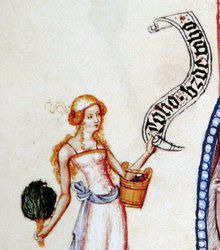

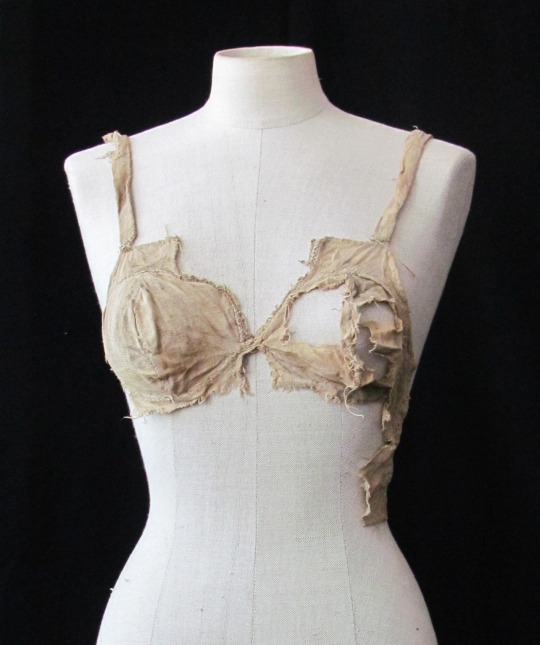
I sewed my own recreation of it (with some alterations because I made it for my everyday use, not as a historical recreation) and did a post about my results, where I go deeper into the history of the garment too. I didn't construct it very well and I did an error in the design of the back, which cause the strain of the shoulder straps to focus too much on very specific spots in the back panel, which eventually made the fabric there break too many times. (There were some other smaller design flaws too, like the waistline is lower than my natural waist so it rose and wrinkled annoyingly.) I did use it daily (except when I washed it) for a fairly long time though and it was super comfortable and helped a lot with back pain (and shoulder pain caused by use of modern bras). I hate that I've had to go back to modern bras because I haven't had the time to remake it yet. (I'll probably make a follow up post once I get around to it, where I go through the issues of the first version and how I addressed them in the next attempt.) Well fitted and shaped bodice which is then laced does surprisingly much even without any additional reinforcements.


I haven't made a Medieval kirtle (though I will some day), but it was the more widely used Medieval supporting garment, which eventually replaced Bathhouse dress in the area where that was used. Kirtle is worn over a shift, but it broadly works similarly. Kirtles could be front, side or back laced depending on the time period and how the Kirtle was constructed. Multiple layers of kirtles could be used and looser overgarments (like houppelande) were often used on top of it. Kirtle was used by everyone, including men, but for those who didn't need bust support, it's purpose was mainly to create the fashionable silhouette. Here's three depictions of kirtles from 15th century. First unlaced, but has lacing on the front, second close up of the side lacing and third shows nicely how both front and side/backlacing shaped the bust.

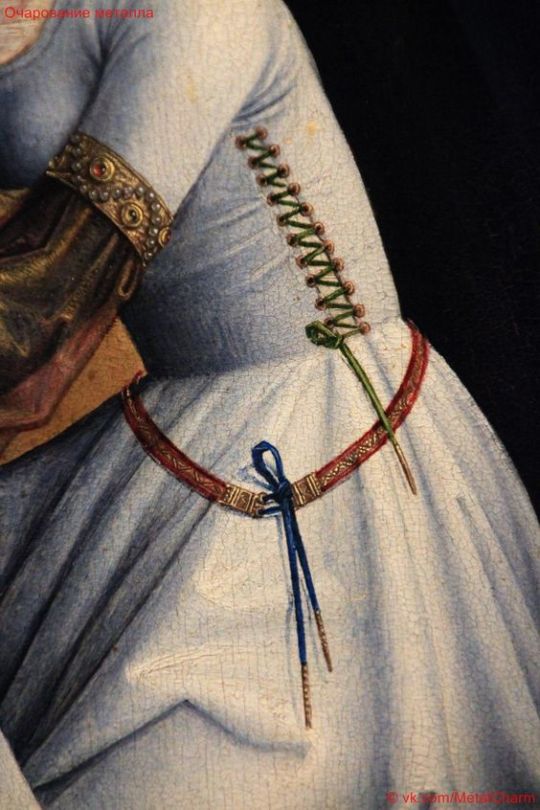
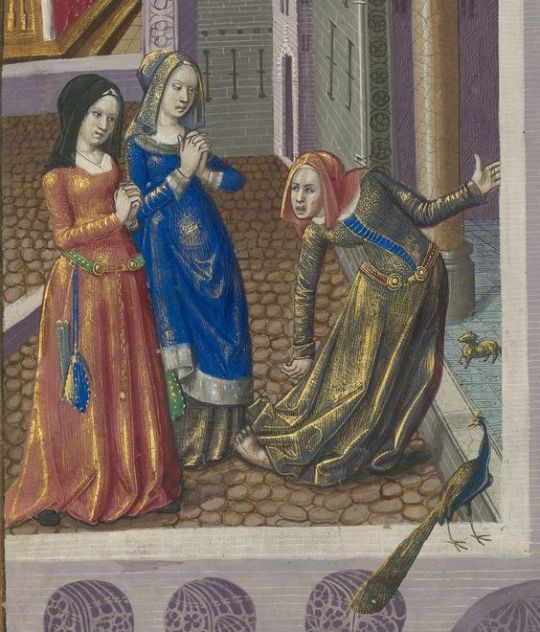
Morgan Donner is a costumer, who focuses a lot on Medieval costuming and has a big bust, so while I haven't personally tested the supportiveness of kirtle, she certainly has. The kirtle bodice part needs to be patterned to accommodate the breasts by giving it round shapes and the kirtle needs to be a little too small so there's room to lace it to fit well. Lining also helps to reinforce the fabric and make it more firm and supportive. Here's Morgan's pattern from the tutorial in her website and how the kirtle eventually fits for her. (Also look at the handsome boy in his handsome matching outfit.)
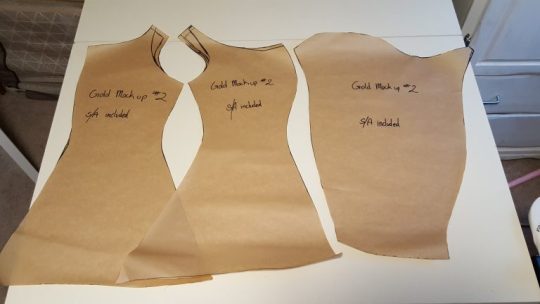
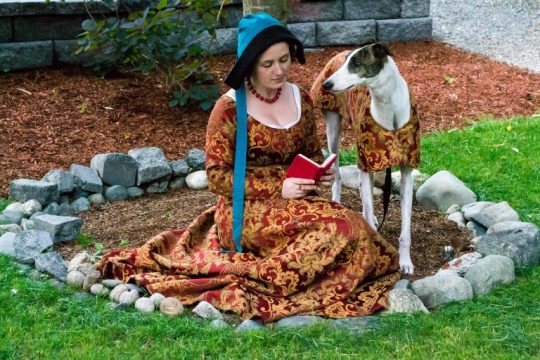
She also has a video relating to the same kirtle project, where she explains her method to pattern a kirtle specifically so it's supportive for big bust.
In 16th century more stiffness was added to kirtles, first with very stiff lining and then with boning, but that doesn't necessarily add to the bust support, rather it just allows the kirtle to shape the bust and the body in general more and better support a heavy skirt. Firm fabric secured snugly with lacing is already very good at distributing the weight of the boobs to the whole torso.
In conclusion, at least since 14th century people with our body type were not doomed to eternal back pain and even before that some ways to help with it were probably used.
#historical fashion#fashion history#dress history#history#historical costuming#historical sewing#sewing#crafts#costuming#fashion#medieval fashion
232 notes
·
View notes
Note
How physically active were actually "medieval" noble women? I know is a long period but I usually see people complaning about noble women in fantasy doing stuff such as hunting or riding horses. I have seen a couple of illustrations of fencing manuals with women in them too.
We, as a culture, especially in the US, have a very bad habit of using the British Regency/Victorian era as the gold standard for how women all over the world were treated throughout history. And the truth is, it ain’t that way. It never was, because women in this exact era used to duel each other in other parts of Europe and often did it topless.
Yes, this is real. We have records of it.
Was it all women, all the time? No. Was it often enough to mention? Yes.
There’s a really good article by Kameron Hurley, “Women Have Always Fought” that goes over the history of women warriors and the laziness of specular fiction in detail. This is a particularly great few paragraphs from the article that covers where our popular conception that women don’t fight comes from.
“Women have always fought,” he said. “Shaka Zulu had an all-female force of fighters. Women have been part of every resistance movement. Women dressed as men and went to war, went to sea, and participated actively in combat for as long as there have been people.”
I had no idea what to say to this. I had been nurtured in the U.S. school system on a steady diet of the Great Men theory of history. History was full of Great Men. I had to take separate Women’s History courses just to learn about what women were doing while all the men were killing each other. It turned out many of them were governing countries and figuring out rather effective methods of birth control that had sweeping ramifications on the makeup of particular states, especially Greece and Rome.
Half the world is full of women, but it’s rare to hear a narrative that doesn’t speak of women as the people who have things done to them instead of the people who do things. More often, women are talked about as a man’s daughter. A man’s wife.
Sounds familiar, doesn’t it?
Check out some of these real women below.
Empress Maude, the daughter of the English King, Henry I, was named her father’s heir after her brother died. While her cousin Stephen stole the throne after her father’s death, she raised an army and took the country into a civil war to take it back. They fought it out for the decade it took for her son to reach adulthood, and laid the groundwork for Henry II to become king. There’s a great novel by Sharon Kay Penman, When Christ and His Saints Slept which chronicles the civil war. If you’re interested in medieval history, I recommend reading it. Her daughter-in-law, Eleanor of Aquitaine, also led an interesting life. (It should be said, real history got to the denied female heir fights for her throne before George R.R. Martin.)
There’s great videos from Xiran Jay Zhao discussing the Chinese warrior queen Fu Hao of the Shang Dynasty and Wu Zetian, who became China’s first female emperor. (Yes, you read that right. Emperor.)
There is Khutulun, the Wrestler Princess and the great-great granddaughter of Gengis Khan, who is one source of our “defeat her in battle to marry her” tropes. She issued this challenge, “defeat her in wrestling, she’ll marry.” She scammed would be suitors out of 10,000 horses. Western male authors are so threatened by Khutulun, they’ve kept trying to rewrite her history by making her fall victim to the power of love. (No, seriously.)
There’s also Hojo Masako, the Buddhist nun who deposed her own son when he proved incompetent and ruled Japan as Shogun. Here’s her wiki entry too.
The Amazons of Greek Myth were real in that they were actual Scythian women who went to war. (As Scythian women did, just like their men.) They terrified and terrorized the Greeks so much, they became immortalized in their mythology. Don’t believe me? Here’s an article from National Geographic and this one from Live Science.
There’s stories like this all throughout history from big events to small ones. (You can find more over at Rejected Princesses if you’re interested.) There are female warriors, female generals, noblewomen who took command of their husbands’ forces, widows who took to the sea to get revenge on those who wronged them, women who rode with their husbands to battle, female assassins, female leaders of rebellions, etc. The women of the Japanese samurai class were trained to fight, and fight they did. Women warriors, queens, and politicians are all over mythology too. You’ll often see these women come out of the upper echelons of society because money creates options, but they are there. Many of those stories are lost to history, in some cases purposefully, and there was a long trend among archeologists that assumed because a person was buried with male grave goods, the body had to be male. We’re now finding out that isn’t true. There’s a significant portion of warrior corpses that have turned out to be female. Assassin’s Creed: Valhalla chose to post a notice about it in response to these exact criticisms you’re questioning.
Those people you see complaining online? They’re clinging to a version of history that doesn’t exist. More, we know it doesn’t, because popular culture is hungry to the point of desperate for aggressive, confident, and competent female characters. If they were truly a lie, they wouldn’t ring true for so many people.
The history we’re taught today largely downplays women’s achievements, contributions, and successes while uplifting those of men. It’s a fact. Go look at famous female figures anywhere, you’ll find the same story at play over and over. Historically, fantasy as a genre largely portrays a world that is, in fact, fantasy, but that fantasy has nothing to do with women doing things they’re not “supposed” to. There’s no clubhouse. There’s nothing unrealistic in imagining your female character is a kickass queen who defeats overconfident men in wrestling competitions and robs them of all their horses. It’s not unrealistic to come up with an ending that doesn’t conclude in tragedy, violent deaths, them “learning their place,” or even locked within the bonds of an unhappy marriage. (Shocker!) Some did, but the truth isn’t universal. It’s not even unrealistic to imagine they might have supportive male family members, love interests, and followers who happily (gasp) assist them in these endeavors. Maude, for reference, had bastard half-brothers who helped her instead of trying to take the throne for themselves.
History got here before fantasy authors. There’s nothing unrealistic about reality. Popular conceptions and common knowledge fed to us by the majority male dominated culture isn’t always the truth. Reality is, it’s the stories we see normalized across the media spectrum that are wrong. The ones that insist women are objects, who commodify their pain, and reframe their stories to ensure the focus remains on men. While this is changing, women are still often treated as the NPCs of male driven stories.
The people you hear complaining? They want storytelling traditions to stay that way, for the Great Man values countless narratives have reinforced to remain unchallenged. Funny as it sounds, they’re threatened by the very existence of narratives that countermand that centralized focus on men being superior, that there is a stratified gender hierarchy, and men taking their place as the sole, worshipful focus of a woman’s existence, much less these female characters being important in their own narratives. If these people weren’t threatened by female characters being people, they wouldn’t say anything. They’d just move on in apathy.
Reality is people are complicated. There’s room for all stripes in all colors and contexts. It’s no secret that history has suppressed and erased countless stories that don’t support the ruling narrative of the dominant culture. These same people forget there’s plenty of storytelling traditions that include women taking their place as warriors in cultures outside America. For all the sexism and misogyny, women fighting is not an alien concept, it’s not even foreign to other Western European traditions.
Believe what your own research is showing you, not what a bunch of idiots who can’t tell their ass from their elbow are whining about. They can’t handle someone who isn’t straight, male, and (most often) white being the central focus. Really, they can’t handle these characters as even a side focus. That’s their loss, it doesn’t have to be yours.
-Michi
This blog is supported through Patreon. Patrons get early access to new posts, and direct access to us through Discord. If you’d like to support us, please consider becoming a Patron.
4K notes
·
View notes
Note
where can i start reading disc world?
(tl;dr version: Either with Guards!Guards! if you want angry urban fantasy or Wyrd Sisters if you want angry rural fantasy, then follow the list for that sub-series)
Oh anon brace yourself, there are in fact several ways people have big opinions on.
These are mine:
1. My least favorite way is from the start in chronological order
the trouble here is the first few Discworld novels were written as these kinda silly goofy fantasy/dnd parodies that weren't even supposed to be a part of a bigger thing and they honestly aren't that good, especially not compared to later books. That's the way I started and I just dropped the series for a few years cause of it, so I really don't recommend it. The author himself said he wasn't that good of a writer back then which is understandable, cause it was like 40 books ago.
2. What I reccomend is in chronological order based on different sub-series
Discworld novels all happen in the same world, but they follow different groups of characters, so you have several sub-series.
I'll post a list here, but it's pretty confusing so I'll also explain two of my favs below.
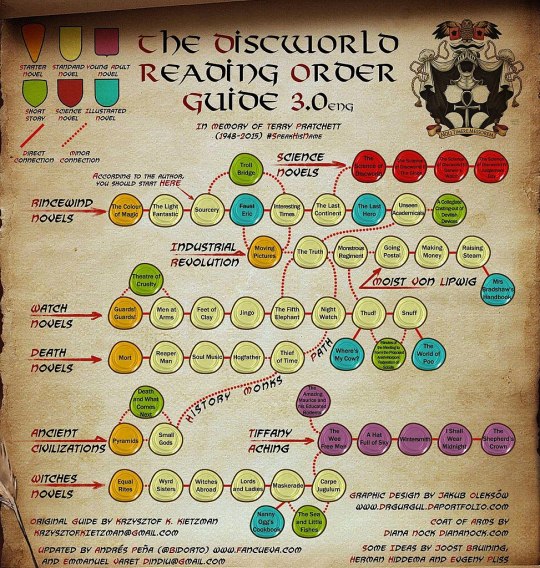
City Novels (Watch novels and Industrial Revolution novels)
About a huge, terrible metropolis and the people that help it run, stumble and sometimes trip over the years.
People normally split this into watch novels which follow the city watch and are crime procedurals/adventure books with a ton of social commentary and industrial revolution novels which are about the city speedrunning from medieval to industrial era via several inventions and follow different main characters who are mostly all there against their will.
To me, the main character is the city itself and I super recommend reading these from start to finish in order to see how it changes with time.
starting book: Guards! Guards!

Witches Novels
About three witches doing witch things in a small mountain kingdom, unless they're going on a trip somewhere.
Incredible horrid old lady characters, a lot of exploration of fantasy tropes, some deep emotional beats, very warm human phlosophy and personal responsibility themes.
There's a semi-seperate "YA" series about a younger witch (Tiffany Aching novels), but don't let that fool you, because those hit just as hard as the "adult" ones.
starting book: Wyrd Sisters (technically Equal Rites, but that's also in the awkward early books period for me)

As for the others, the death novels are also very very good, Small Gods is an amazing standalone book and I'd literally just avoid the Rincewind novels until you're already hooked on the series, but they probably have their fans too.
3. Just pick up a random book you see in the library
A tried and tested method a lot of people swear by, most of the books are standalone enough for this to work, BUT my personal opinion is at least the city books should be read in order (especially Night Watch) and there's several less than stellar books you could pick up first by mistake this way (Color of Magic, Light Fantastic, Interesting Times and Faust being the worst imo).
#discworld#this is my personal opinion ofc but imagine your first books was interesting times#everytime someone asks me how to get into discworld i transform into that look how hard i can piss comic
3K notes
·
View notes
Note
hi CT, unsure if this has been asked before (likely) but im gonna shoot. what is the actual historical origin of witches/witchcraft? especially in the sense of the term itself, but also whatever folk practice it may have come to refer to. it's so hard to get a straight answer about this because, well, you know.
Witchcraft isn't really a historical thing at all. What people consider witchcraft is the result of a big ball of things that the Catholic church declared to be Not Allowed.
In the late 1700s there was a renewed interest in pre-christian European folklore, and it kinda snowballed into coinciding with the rise of Spiritualism. Around the 1850s, you had this romanticization of an imagined pre-christian past. You can see a lot of this st that shows up in stuff like the poetry of W.B. Yeats.
In the 1920s you get Margaret Murray and her (entirely debunked) theory that "Witchcraft" was a actually a unified secret religion that survived the witch burnings of the late medieval era.
Then in 1954 a retired Rosicrucian named Gerald Gardener basically said "we should treat that as real and make a religion around it." And then he did that.
2K notes
·
View notes
Text

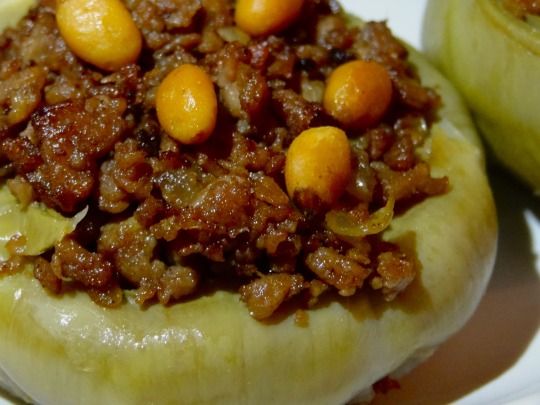
[ID: The first image is of four stuffed artichoke hearts on a plate with a mound of rice and fried vermicelli; the second is a close-up on one artichoke, showing fried ground 'beef' and golden pine nuts. End ID]
أرضي شوكي باللحم / Ardiyy-shawkiyy b-al-lahm (Stuffed artichoke hearts)
Artichoke hearts stuffed with spiced meat make a common dish throughout West Asia and North Africa, with variations on the recipe eaten in Lebanon, Syria, Palestine, Algeria, and Morocco. In Palestine, the dish is usually served on special occasions, either as an appetizer, or as a main course alongside rice. The artichokes are sometimes paired with cored potatoes, which are stuffed and cooked in the same manner. Stuffed artichokes do not appear in Medieval Arab cookbooks (though artichokes do), but the dish's distribution indicates that its origin may be Ottoman-era, as many other maḥshis (stuffed dishes) are.
The creation of this dish is easy enough once the artichoke hearts have been excavated (or, as the case may be, purchased frozen and thawed): they are briefly deep-fried, stuffed with ground meat and perhaps pine nuts, then stewed in water, or water and tomato purée, or stock, until incredibly tender.
While simple, the dish is flavorful and well-rounded. A squeeze of lemon complements the bright, subtle earthiness of the artichoke and cuts through the richness of the meat; the fried pine nuts provide a play of textures, and pick up on the slight nutty taste that artichokes are known for.
Terminology and etymology
Artichokes prepared in this way may be called "ardiyy-shawkiyy b-al-lahm." "Ardiyy-shawkiyy" of course means "artichoke"; "ب" ("b") means "with"; "ال" ("al") is the determiner "the"; and "لَحْم" ("laḥm") is "meat" (via a process of semantic narrowing from Proto-Semitic *laḥm, "food"). Other Palestinian Arabic names for the same dish include "أرضي شوكي محشي" ("ardiyy-shawkiyy maḥshi," "stuffed artichokes"), and "أرضي شوكي على ادامه" ("ardiyy-shawkiyy 'ala adama," "artichokes cooked in their own juice").
The etymology of the Levantine dialectical phrase meaning "artichoke" is interestingly circular. The English "artichoke" is itself ultimately from Arabic "الخُرْشُوف" ("al-khurshūf"); it was borrowed into Spanish (as "alcarchofa") during the Islamic conquest of the Iberian peninsula, and thence into English via the northern Italian "articiocco." The English form was probably influenced by the word "choke" via a process of phono-semantic matching—a type of borrowing wherein native words are found that sound similar to the foreign word ("phonetics"), and communicate qualities associated with the object ("semantics").
"Artichoke" then returned to Levantine Arabic, undergoing another process of phono-semantic matching to become "ardiyy-shawkiyy": أَرْضِيّ ("ʔarḍiyy") "earthly," from أَرْض ("ʔarḍ"), "Earth, land"; and شَوْكِيّ ("shawkiyy") "prickly," from شَوْك ("shawk"), "thorn."
Artichokes in Palestine
Artichoke is considered to be very healthful by Palestinian cooks, and it is recommended to also consume the water it is boiled in (which becomes delightfully savory and earthy, suitable as a broth for soup). In addition to being stuffed, the hearts may be chopped and cooked with meat or potatoes into a rich soup. These soups are enjoyed especially during Ramadan, when hot soup is popular regardless of the season—but the best season for artichokes in the Levant is definitively spring. Stuffed artichokes are thus often served by Jewish people in North Africa and West Asia during Passover.
Artichokes grow wild in Palestine, sometimes in fields adjacent to cultivated crops such as cereals and olives. Swiss traveler Johann Ludwig Burckhardt, writing in 1822, referred to the abundant wild artichoke plants (presumably Cynara syriaca) near لُوبْيا ("lūbyā"), a large village of stone buildings on a hilly landscape just west of طبريا ("ṭabariyya," Tiberias):
About half an hour to the N. E. [of Kefer Sebt (كفر سبط)] is the spring Ain Dhamy (عين ظامي), in a deep valley, from hence a wide plain extends to the foot of Djebel Tor; in crossing it, we saw on our right, about three quarters of an hour from the road, the village Louby (لوبي), and a little further on, the village Shedjare (شجره). The plain was covered with the wild artichoke, called khob (خُب); it bears a thorny violet coloured flower, in the shape of an artichoke, upon a stem five feet in height.
(Despite resistance from local militia and the Arab Liberation Army, Zionist military groups ethnically cleansed Lubya of its nearly 3,000 Palestinian Arab inhabitants in July of 1948, before reducing its buildings and wells to rubble, The Jewish National Fund later planted the Lavi pine forest over the ruins.)
Artichokes are also cultivated and marketed. Elihu Grant, nearly a century after Burckhardt's writing, noted that Palestinian villages with sufficient irrigation "[went] into gardening extensively," and marketed their goods in crop-poor villages or in city markets:
Squash, pumpkin, cabbage, cauliflower, lettuce, turnip, beet, parsnip, bean, pea, chick-pea, onion, garlic, leek, radish, mallow and eggplant are common varieties [of vegetable]. The buds of the artichoke when boiled make a delicious dish. Potatoes are getting to be quite common now. Most of them are still imported, but probably more and more success will be met in raising a native crop.
Either wild artichokes (C. syriaca) or cardoons (C. cardunculus, later domesticated to yield modern commerical artichokes) were being harvested and eaten by Jewish Palestinians in the 1st to the 3rd centuries AD (the Meshnaic Hebrew is "עַכָּבִיּוֹת", sg. "עַכָּבִית", "'aqubit"; related to the Arabic "عَكُوب" "'akūb," which refers to a different plant). The Tosefta Shebiit discusses how farmers should treat the sprouting of artichokes ("קינרסי," "qinrasi") during the shmita year (when fields are allowed to lie fallow), indicating that Jews were also cultivating artichokes at this time.
Though artichokes were persistently associated with wealth and the feast table (perhaps, Susan Weingarten speculates, because of the time they took to prepare), trimming cardoons and artichokes during festivals, when other work was prohibited, was within the reach of common Jewish people. Those in the "upper echelons of Palestinian Jewish society," on the other hand, had access to artichokes year-round, including (through expensive marvels of preservation and transport) when they were out of season.
Jewish life and cuisine
Claudia Roden writes that stuffed artichoke, which she refers to as "Kharshouf Mahshi" (خرشوف محشي), is "famous as one of the grand old Jerusalem dishes" among Palestinian Jews. According to her, the stuffed artichokes used to be dipped in egg and then bread crumbs and deep-fried. This breading and frying is still referenced, though eschewed, in modern Sephardi recipes.
Prior to the beginning of the first Aliyah (עלייה, wave of immigration) in 1881, an estimated 3% of the overall population of Palestine, or 15,011 people, were Jewish. This Jewish presence was not the result of political Zionist settler-colonialism of the kind facilitated by Britain and Zionist organizations; rather, it consisted of ancestrally Palestinian Jewish groups, and of refugees and religious immigrants who had been naturalized over the preceding decades or centuries.
One such Jewish community were the Arabic-speaking Jews whom the Sephardim later came to call "מוּסְתערבים" or "مستعربين" ("Musta'ravim" or "Musta'ribīn"; from the Arabic "مُسْتَعْرِب" "musta'rib," "Arabized"), because they seemed indifferentiable from their Muslim neighbors. A small number of them were descendants of Jews from Galilee, which had had a significant Jewish population in the mid-1st century BC; others were "מגרבים" ("Maghrebim"), or "مغربية" ("Mughariba"): descendents of Jews from Northwest Africa.
Another major Jewish community in pre-mandate Palestine were Ladino-speaking descendents of Sephardi Jews, who had migrated to Palestine in the decades following their expulsion from Spain and then Portugal in the late 15th century. Though initially seen as foreign by the 'indigenous' Mista'avim, this community became dominant in terms of population and political influence, coming to define themselves as Ottoman subjects and as the representatives of Jews in Palestine.
A third, Yiddish- and German-speaking, Askenazi Jewish population also existed in Palestine, the result of immigration over the preceding centuries (including a large wave in 1700).
These various groups of Jewish Palestinians lived as neighbors in urban centers, differentiating themselves from each other partly by the language they spoke and partly by their dress (though Sephardim and Ashkenazim quickly learned Arabic, and many Askenazim and Muslims learned Ladino). Ashkenazi women also learned from Sephardim how to prepare their dishes. These groups' interfamiliarity with each other's cuisine is further evidenced by the fact that Arabic words for Palestinian dishes entered Ladino and Yiddish (e.g. "كُفْتَة" / "kufta," rissole; "مَزَّة" "mazza," appetizer); and words entered Arabic from Ladino (e.g. "דונסי" "donsi," sweet jams and fruit leather; "בוריק" "burek," meat and cheese pastries; "המים" "hamim," from "haminados," braised eggs) and Yiddish (e.g. "לעקעך" "lakach," honey cake).
In addition to these 'native' Jews were another two waves of Ashkenazi migration in the late 18th and early-to-mid 19th centuries (sometimes called the "היישוב הישן," "ha-yishuv ha-yashan," "old settlement," though the term is often used more broadly); and throughout the previous centuries there had also been a steady trickle of religious immigration, including elderly immigrants who wished to die in Jerusalem in order to be present at the appointed place on the day of Resurrection. Recent elderly women immigrants unable to receive help from charitable institutions would rely on the community for support, in exchange helping the young married women of the neighborhood with childcare and with the shaping of pastries ("מיני מאפה").
In the first few centuries AD, the Jewish population of Palestine were largely farmers and agricultural workers in rural areas. By the 16th century, however, most of the Jewish population resided in the Jewish Holy Cities of Jerusalem (القُدس / al-quds), Hebron (الخليل / al-khalil), Safed (صفد), and Tiberias (طبريا / ṭabariyya). In the 19th century, the Jewish population lived entirely in these four cities and in expanding urban centers Jaffa and Haifa, alongside Muslims and Christians. Jerusalem in particular was majority Jewish by 1880.
In the 19th century, Jewish women in Jerusalem, like their Christian and Muslim neighbors, used communal ovens to bake the bread, cakes, matzah, cholent, and challah which they prepared at home. One woman recalls that bread would be sent to the baker on Mondays and Thursdays—but bribes could be offered in exchange for fresh bread on Shabbat. Charges would be by the item, or else a fixed monthly payment.
Trips to the ovens became social events, as women of various ages—while watching the bakers, who might not put a dish in or take it out in time—sent up a "clatter" of talking. During religious feast days, with women busy in the kitchen, some families might send young boys in their stead.
Markets and bakeries in Jerusalem sold bread of different 'grades' based on the proportion of white and wheat flour they contained; as well as flatbread (خبز مفرود / חובז מפרוד / khobbiz mafroud), Moroccan מאווי' / ماوي / meloui, and semolina breads (כומאש / كماج / kmaj) which Maghrebim especially purchased for the Sabbath.
On the Sabbath, those who had brick ovens in their sculleries would keep food, and water for tea and coffee, warm from the day before (since religious law prohibits performing work, including lighting fires, on Shabbat); those who did not would bring their food to the oven of a neighbor who did.
Palestinian Jewish men worked in a variety of professions: they were goldsmiths, writers, doctors, merchants, scientists, linguists, carpenters, and religious scholars. Jewish women, ignoring prohibitions, engaged in business, bringing baked goods and extra dairy to markets in Jerusalem, grinding and selling flour, spinning yarn, and making clothing (usually from materials purchased from Muslims); they were also shopkeepers and sellers of souvenirs and wine. Muslims, Jews, and Christians shared residential courtyards, pastimes, commercial enterprises, and even holidays and other religious practices.
Zionism and Jewish Palestinians
Eastern European Zionists in the 1880s and 90s were ambivalent towards existing Jewish communities in Palestine, often viewing them as overly traditional and religious, backwards-thinking, and lacking initiative. Jewish Palestinians did not seem to conform with the land-based, agricultural, and productivist ideals of political Zionist thinkers; they were integrated into the Palestinian economy (rather than seeking to create their own, segregated one); they were not working to create a Jewish ethnostate in Palestine, and seemed largely uninterested in nationalist concerns. Thus they were identified with Diaspora Jewish culture, which was seen as a remnant of exile and oppression to be eschewed, reformed, or overthrown.
These attitudes were applied especially to Sephardim and Mista'arevim, who were frequently denigrated in early Zionist literature. In 1926, Revisionist Zionist leader Vladimir Jabotinsky wrote that the "Jews, thank God, have nothing in common with the East. We must put an end to any trace of the Oriental spirit in the Jews of Palestine." The governance of Jewish communities was, indeed, changed with the advent of the British Mandate (colonial rule which allowed the British to facilitate political Zionist settling), as European political and "socialist" Zionists promoted Ashkenazi over Sephardi leadership.
Under the Ottomans, the millet system had allowed a degree of Jewish and Christian autonomy in matters of religious study and leadership, cultural and legal affairs, and the minting of currency. The religious authority of all Jewish people in Palestine had been the Sephardi Rabbi of Jerusalem, and his authority on matters of Jewish law (like the authority of the Armenian Patriarchate on matters of Christian law) extended outside of Palestine.
But British and European funding allowed newer waves of Ashkenazi settlers (sometimes called "היישוב החדש," "ha-yishuv ha-khadash," "new settlement")—who, at least if they were to live out the ideals of their sponsors, were more secular and nationalist-minded than the prior waves of Ashkenazi immigration—to be de facto independent of Sephardi governance. Several factors lead to the drying up of halaka (donated funds intended to be used for communal works and the support of the poor in Sephardi communities), which harmed Sephardim economically.
Zionist ideas continued to dominate newly formed committees and programs, and Palestinian and Sephardi Jews reported experiences of racial discrimination, including job discrimination, leading to widespread poverty. The "Hebrew labor" movement, which promoted a boycott of Palestinian labor and produce, in fact marginalized all workers racialized as Arab, and promises of work in Jewish labor unions were divided in favor of Ashkenazim to the detriment of Sephardim and Mizrahim. This economic marginalization coincided with the "social elimination of shared indigenous [Palestinian] life" in the Zionist approach to indigenous Jews and Muslims.
Despite the adversarial, disdainful, and sometimes abusive relationship which the European Zionist movement had with "Oriental" Jews, their presence is frequently used in Zionist food and travel writing to present Israel as a multicultural and pluralist state. Dishes such as stuffed artichokes are claimed as "Israeli"—though they were eaten by Jews in Palestine prior to the existence of the modern state of Israel, and though Sephardi and Mizrahi diets were once the target of a civilizing, correcting mission by Zionist nutritionists. The deep-frying that stuffed artichokes call for brings to mind European Zionists' half-fascinated, half-disgusted attitudes towards falafel.
The point is not to claim a dish for any one national or ethnic group—which is, more often than not, an exercise in futility and even absurdity—but to pay attention to how the rhetoric of food writing can obscure political realities and promote the colonizer's version of history. The sinking of Jewish Palestinian life prior to the advent of modern political Zionism, and the corresponding insistence that it was Israel that brought "Jewish cuisine" to Palestine, allow for such false dichotomies as "Jewish-Palestinian relations" or "Jewish-Arab relations"; these descriptors further Zionist rhetoric by making a clear situation of ethnic cleansing and settler-colonialism sound like a complex and delicate issue of inter-ethnic conflict. To boot, the presentation of these communities as having merely paved the way to Zionist nationalism ignores their existence as groups with their own political, social, and cultural lives and histories.
Help evacuate a Gazan family with Operation Olive Branch
Buy an eSim for use in Gaza
Help Anera provide food in Gaza
Ingredients:
Serves 4 (as a main dish).
For the artichokes:
6 fresh, very large artichokes; or frozen (not canned) whole artichoke hearts
1 lemon, quartered (if using fresh artichokes)
250g (1 1/2 cups) vegetarian ground beef substitute; or 3/4 cup TVP hydrated with 3/4 cup vegetarian 'beef' stock from concentrate
1 yellow onion, minced
Scant 1/2 tsp kosher salt
1/2 tsp ground black pepper
1 pinch ground cardamom (optional)
1/4 tsp ground allspice or seb'a baharat (optional)
1 Tbsp pine nuts (optional)
Water, to simmer
Oil, to fry
2 tsp vegetarian 'beef' stock concentrate, to simmer (optional)
Lemon, to serve
Larger artichokes are best, to yield hearts 3-4 inches in width once all leaves are removed. If you only have access to smaller artichokes, you may need to use 10-12 to use up all the filling; you might also consider leaving some of the edible internal leaves on.
The meat may be spiced to taste. Sometimes only salt and black pepper are used; some Palestinian cooks prefer to include seb'a baharat, white pepper, allspice, nutmeg, cardamom, and/or cinnamon.
Medieval Arab cookbooks sometimes call for vegetables to be deep-fried in olive oil (see Fiḍālat al-Khiwān fī Ṭayyibāt al-Ṭaʿām wa-l-Alwān, chapter 6, recipe no. 373, which instructs the reader to treat artichoke hearts this way). You may use olive oil, or a neutral oil such as canola or sunflower (as is more commonly done in Palestine today).
Elihu Grant noted in 1921 that lemon juice was often served with stuffed vegetable dishes; today stuffed artichokes are sometimes served with lemon.
For the rice:
200g Egyptian rice (or substitute any medium-grained white rice)
2 tsp broken semolina vermicelli (شعيريه) (optional)
1 tsp olive oil (optional)
Large pinch salt
520g water, or as needed
Broken semolina vermicelli (not rice vermicelli!) can be found in plastic bags at halal grocery stores.
Instructions:
For the stuffed artichokes:
1. Prepare the artichoke hearts. Cut off about 2/3 of the top of the artichoke (I find that leaving at least some of the stem on for now makes it easier to hollow out the base of the artichoke heart without puncturing it).
2. Pull or cut away the tough outer bracts ("leaves") of the artichoke until you get to the tender inner leaves, which will appear light yellow all the way through. As you work, rub a lemon quarter over the sides of the artichoke to prevent browning.
3. If you see a sharp indentation an inch or so above the base of the artichoke, use kitchen shears or a sharp knife to trim off the leaves above it and form the desired bowl shape. Set aside trimmings for a soup or stew.
4. Use a small spoon to remove the purple leaves and fibers from the center of the artichoke. Make sure to scrape the spoon all along the bottom and sides of the artichoke and get all of the fibrous material out.
5. Use a paring knife to remove any remaining tough bases of removed bracts and smooth out the base of the artichoke heart. Cut off the entire stem, so that the heart can sit flat, like a bowl.
6. Place the prepared artichoke heart in a large bowl of water with some lemon juice squeezed into it. Repeat with each artichoke.
7. Drain artichoke hearts and pat dry. Heat a few inches of oil in a pot or wok on medium and fry artichoke hearts, turning over occasionally, for a couple minutes until lightly browned. If you don't want to deep-fry, you can pan-fry in 1 cm or so of oil, flipping once. Remove with a slotted spoon and drain.
8. Prepare the filling. Heat 1 tsp of olive oil in a large skillet on medium-high and fry onions, agitating often, until translucent.
Tip: Some people add the pine nuts and brown them at this point, to save a step later. If you do this, they will of course be mixed throughout the filling rather than being a garnish on top.
9. Add spices, salt, and meat substitute and fry, stirring occasionally, until meat is browned. (If using TVP, brown it by allowing it to sit in a single layer undisturbed for 3-4 minutes, then stir and repeat.) Taste and adjust spices and salt.
10. Heat 1 Tbsp of olive oil or margarine in a small pan on medium-low. Add pine nuts and fry, stirring constantly, until they are a light golden brown, then remove with a slotted spoon. Note that, once they start taking on color, they will brown very quickly and must be carefully watched. They will continue to darken after they are removed from the oil, so remove them when they are a shade lighter than desired.
11. Stuff the artichoke hearts. Fill the bowl of each heart with meat filling, pressing into the bottom and sides to fill completely. Top with fried pine nuts.
12. Cook the artichoke hearts. Place the stuffed artichoke hearts in a single layer at the bottom of a large stock pot, along with any extra filling (or save extra filling to stuff peppers, eggplant, zucchini, or grape leaves).
13. Whisk stock concentrate into several cups of just-boiled water, if using—if not, whisk in about a half teaspoon of salt. Pour hot salted water or stock into the pot to cover just the bottoms of the stuffed artichokes.
14. Simmer, covered, for 15-20 minutes, until the artichokes are tender. Simmer uncovered for another 5-10 minutes to thicken the sauce.
For the rice:
1. Rinse your rice once by placing it in a sieve, putting the sieve in a closely fitting bowl, then filling the bowl with water; rub the rice between your fingers to wash, and remove the sieve from the bowl to strain.
2. Place a bowl on a kitchen scale and tare. Add the rice, then add water until the total weight is 520g. (This will account for the amount of water stuck to the rice from rinsing.)
3. (Optional.) In a small pot with a close-fitting lid, heat 1 tsp olive oil. Add broken vermicelli and fry, agitating often, until golden brown.
4. Add the rice and water to the pot and stir. Increase heat to high and allow water to come to a boil. Cover the pot and lower heat to a simmer. Cook the rice for 15 minutes. Remove from heat and steam for 10 minutes.
To serve:
1. Plate artichoke hearts on a serving plate alongside rice and lemon wedges; or, place artichoke hearts in a shallow serving dish, pour some of their cooking water in the base of the dish, and serve rice on a separate plate.
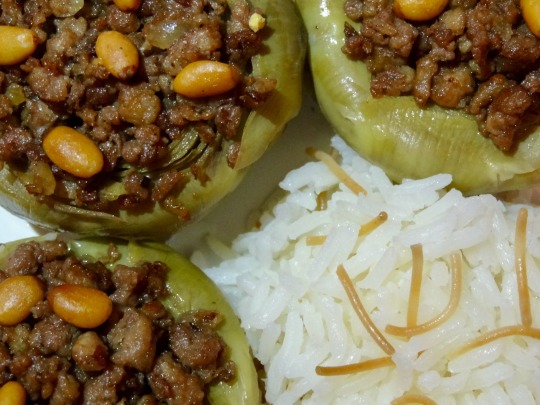
Tip: The white flesh at the base of the bracts (or "leaves") that you removed from the artichokes for this recipe is also edible. Try simmering removed leaves in water, salt, and a squeeze of lemon for 15 minutes, then scraping the bract between your teeth to eat the flesh.
181 notes
·
View notes
Text
Aziraphale's Ring Is a Queer Symbol
In a previous post I hold forth about the symbolism of the lion rampant on the escutcheon of Aziraphale's signet ring. The upshot is that the golden lion is used by Heaven as a symbol of its threat and its merciless, murderous corporate culture, and I argue that in S3 Aziraphale must subvert this stamp of Heavenly ownership and symbolically redefine the golden lion by summoning the courage to be soft.

Now I've learned some new stuff about how signet rings are worn. Come, sistren, and get nerdy with me.
Aziraphale's ring is one of several we see angels wearing in Good Omens. Here in an indispensably useful post, @indigovigilance lists the known rings of Show Omens angels and those rings' qualities and placement. Note how of the angels who have rings, everyone except Saraqael and Aziraphale wear their rings on their LEFT pinky fingers. There's a reason for this.
Since the medieval period in Britain and Germany, and from there in the U.S., signet rings have been bestowed by professional associations as a sign of membership, particularly at the upper end of society: trade guilds, colleges, hospitals, the Church(es), noble families, and societies like the Freemasons all issue(d) signet rings to some of their members. The traditional placement for signet rings of show professional affiliation is the left pinky finger.
In fact, as it was not socially acceptable in or past the Victorian era for men to wear rings on more than one finger, men who wore signet rings and wedding rings both would have their wedding rings sized to fit the pinky finger below the signet. If a ring had to be moved to preserve masculinity, it wasn't the pinky ring that was going anywhere.
Family signets can be worn on any of a number of fingers, but since the Victorian period the men of the British Royal Family (who are from Germany) have been especial sticklers about wearing their signets on their left pinky fingers as well.
So. If you're British and you have a signet ring that's meant to indicate professional affiliation, you wear it on your left pinky.
But Aziraphale wears his signet ring on his RIGHT hand.
Before I offer my opinion on what that means, here's some more fun background on the history and significance of pinky rings in Anglo-American culture:
The Victorian period was when pinky rings started to become associated with queerness.
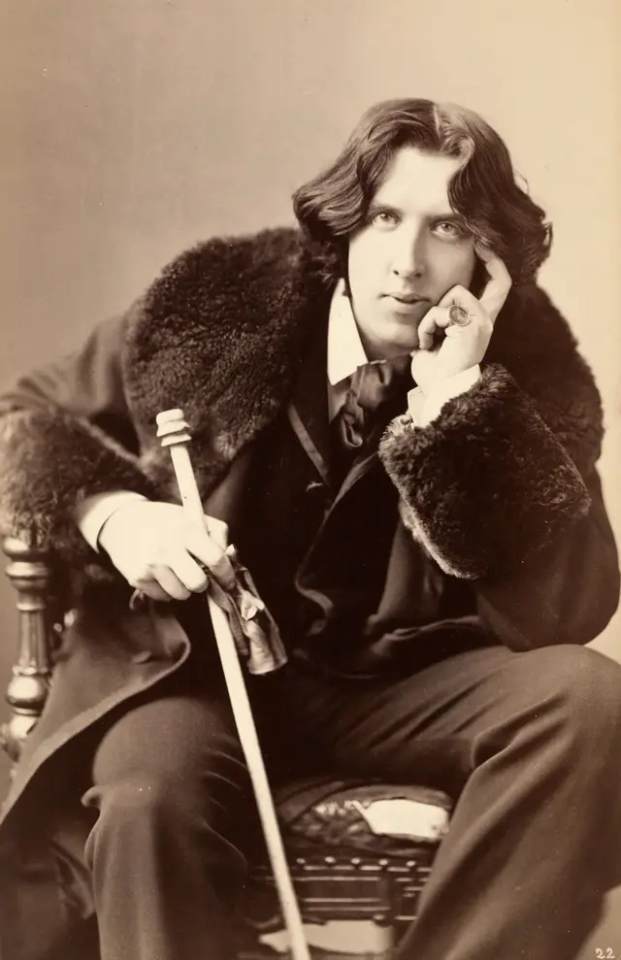
As fellow members of the Hundred Guineas Club, Oscar Wilde and Aziraphale would likely have been acquaintances.

According to Wikipedia (ibid.):
"During the Victorian era, both single men and women uninterested in pursuing marriage could wear a ring on the little finger of their left hand."
This quickly expanded to a pinky ring on either hand. Here's Wikipedia's picture of farmer and philanthropist Caroline Rose Foster in 1917, the Edwardian era, wearing a pinky ring on her right hand:
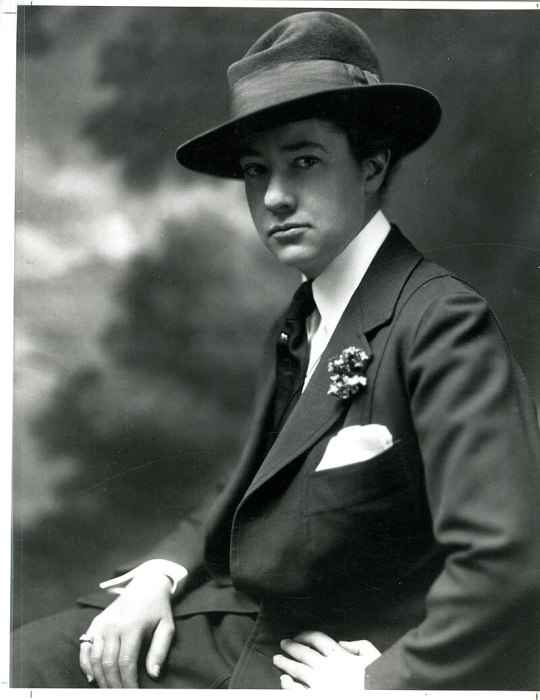
Do you smell a euphemism in "uninterested in pursuing marriage"? I do!
By midcentury--so only 30 years after Ms Foster up there--American and British queers, both men and women, were using signet pinky rings specifically to signal queerness to each other.
"For gay men in the 1950’s and 60’s, a way of signaling to others was through the wearing of a signet ring on the pinkie finger."
"During the 1950’s and 60’s signet rings were worn to signify membership of the gay community; both lesbians and homosexual men wore such rings."
The pinky rings @indigovigilance points out Maggie wears may mean she's an angel; they also match her midcentury lesbian style. Devious of the costumers to give her pinky rings on both hands rather than commit to one or the other.
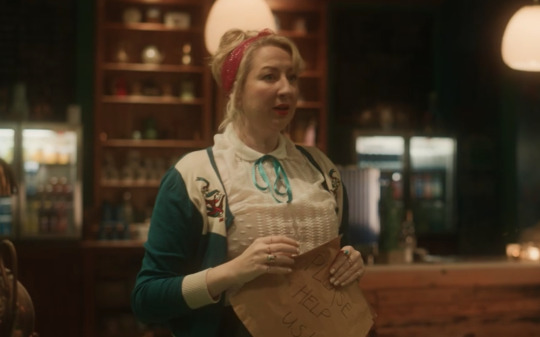
Screenshot by @indigovigilance
To review, there are three reasons a person in Anglo-American culture might wear a pinky ring:
They just feel like it--This can be any kind of ring and can be worn on either hand or both
Professional affiliation--This is a signet ring worn on the left pinky finger
To signal queerness--This is a signet ring and can be worn on either pinky finger
Aziraphale has worn a signet ring on his RIGHT pinky finger at least since he repaired the Eastern "Gate" in the Wall of Eden, so I'm not suggesting that he adopted the 20th-century pinky signet trend to signal his queerness (although as a clockably 'gay' 'man,' Soho fixture, and member of the Hundred Guineas Club, he may well have started it).
What I am suggesting is that Aziraphale has been given a ring by Heaven that Heaven intends him to use to show his professional affiliation, but as with the flaming sword he gives away, Aziraphale doesn't use the ring for its intended purpose. By wearing the ring on his right hand, Aziraphale removes the option of interpreting it as a symbol of his professional affiliation with Heaven and renders it strictly a personal ornament. He subverts a symbol of Heavenly menace into an object of beauty and queerness.
I mean queerness in both senses. If a human takes any symbolic notice of his ring, they'll note the signet is on his right hand and conclude Aziraphale is gay. If another angel takes any notice of it, they'll conclude Aziraphale is a bit odd--that he doesn't pay attention to the finer points of how to fit in with the archangels, doesn't do things like other angels do.
In conclusion, pinky signet rings as a queer signal are just the fucking coolest and I vote we bring them back immediately.
#good omens#good omens s2#good omens 2#aziraphale#aziraphale's ring#good omens lgbtq#pinky rings lgbtq#pinky rings as queer flagging#good omens angel rings#saraqael#michael#uriel#sandalphon
377 notes
·
View notes
Text
i like how the inclusion of The Warrior as an aspect of god in asoiaf catholicism makes it absurdly suited to reaching heaven through violence. the only ‘holy’ war in the medieval era was explicitly crusading in church interests most theologians would tell you unambiguously most men fighting earthly wars (ESPECIALLY knights who had a choice) went directly to hell. in asoiaf arguably all bloodshed is religiously charged
211 notes
·
View notes